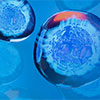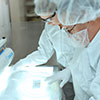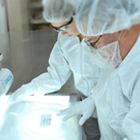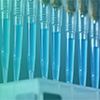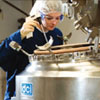Eiwitten en peptiden
Itemnummer:
(PRSI91-862)
Leverancier:
ProSci Inc.
Omschrijving:
Limbic system-associated membrane protein is also known as LSAMP, IgLON family member 3. In humans, it is encoded by the LSAMP gene. It belongs to the immunoglobulin superfamily and contains 3 Ig-like C2-type domains. Limbic system-associated membrane protein mediates selective neuronal growth and axon targeting. It contributes to the guidance of developing axons and remodeling of mature circuits in the limbic system. It is also essential for normal growth of the hyppocampal mossy fiber projection
UOM:
1 * 50 µG
Itemnummer:
(PRSI91-861)
Leverancier:
ProSci Inc.
Omschrijving:
Leukocyte immunoglobulin-like receptor subfamily A member 3 is also known as CD85 antigen-like family member E, Immunoglobulin-like transcript 6, ILT-6, Leukocyte immunoglobulin-like receptor 4, LIR-4 and Monocyte inhibitory receptor HM43/HM31. In humans, it is encoded by the LILRA3 gene. It acts as soluble receptor for class I MHC antigens. Binds both classical and non-classical HLA class I molecules but with reduced affinities compared to LILRB1 or LILRB2.It is detected in B-cells, natural killer (NK) cells, peripheral blood monocytes and lung.
UOM:
1 * 50 µG
Itemnummer:
(PRSI91-309)
Leverancier:
ProSci Inc.
Omschrijving:
Cystatin-M is a typical secretory protein. It is synthesized as a preprotein with a patent N-terminal signal sequence.It belongs to the cystatin family. The most widely accepted function of cystatins is that of protease inhibitors. Most cysteine proteases are confined within cells where optimal pH and redox conditions favor their enzymatic activity. Thus, the majority of intracellular cysteine proteases are inactivated by oxidizing conditions outside the cells. Among the various types of intracellular cysteine proteases, cystatins seem to target preferentially endosomal/lysosomal cysteine proteases of the papain family, such as cathepsin B, cathepsin K/O2, cathepsin L, cathepsin L2/V and cathepsin S. Another important function of Cst6 seems to be in the terminal differentiation of stratified squamous epithelial cells and in the formation of cornified envelops. Cst6 is believed to be important in fine-tuning the enzymatic activities of endosomal/lysosomal cysteine proteases such as cathepsin L, cathepsin L2/V and AEP/mammalian legumain. Deregulated activity of these proteases could lead to abnormal activation of transglutaminases and disorders in cornification.
UOM:
1 * 50 µG
Itemnummer:
(PRSI92-314)
Leverancier:
ProSci Inc.
Omschrijving:
EPDR1 is a member of the ependymin family. EPDR1 is a type II transmembrane protein that is similar to two families of cell adhesion molecules, the protocadherins and ependymins. It may play a role in calcium-dependent cell adhesion. EPDR1 is glycosylated, and the orthologous mouse protein is localised to the lysosome. Alternative splicing results in multiple transcript variants. A related pseudogene has been identified on chromosome 8.
UOM:
1 * 50 µG
Itemnummer:
(PRSI6189P)
Leverancier:
ProSci Inc.
Omschrijving:
RHAMM peptide is used for blocking the activity of RHAMM antibody.
UOM:
1 * 50 µG
Itemnummer:
(PRSI4661P)
Leverancier:
ProSci Inc.
Omschrijving:
Bst2 peptide is used for blocking the activity of Bst2 antibody.
UOM:
1 * 50 µG
Itemnummer:
(PRSI92-324)
Leverancier:
ProSci Inc.
Omschrijving:
Clusterin(CLU) is a secreted protein which belongs to the clusterin family. It is also a 75 - 80 kDa disulfide-linked heterodimeric protein associated with the clearance of cellular debris and apoptosis. Clusterin is an enigmatic glycoprotein with a nearly ubiquitous tissue distribution and an apparent involvement in biological processes ranging from mammary gland involution to neurodegeneration in Alzheimer's disease. Its major form, a heterodimer, is secreted and present in physiological fluids, but truncated forms targeted to the nucleus have also been identified. It is a widely distributed glycoprotein with a wide range of biologic properties. A prominent and defining feature of clusterin is its marked induction in such disease states as glomerulonephritis, cystic renal disease, renal tubular injury, neurodegenerative conditions, atherosclerosis, and myocardial infarction. Upregulation of clusterin mRNA and protein levels detected in diverse disease states and in in vitro systems have led to suggestions that it functions in membrane lipid recyclling, in apoptotic cell death, and as a stress-induced secreted chaperone protein, amongst others.
UOM:
1 * 50 µG
Itemnummer:
(PRSI92-138)
Leverancier:
ProSci Inc.
Omschrijving:
CST Complex Subunit STN1 (OBFC1) is a 368 amino acid protein that contains one OB DNA-binding domain. It is a member of the STN1 family. OBFC1 is component of the CST complex, a complex that binds to single-stranded DNA and is required to protect telomeres from DNA degradation. The CST complex binds single-stranded DNA with high affinity in a sequence-independent manner, while isolated subunits bind DNA with low affinity by themselves. In addition to telomere protection, the CST complex has probably a more general role in DNA metabolism at non-telomeric sites.
UOM:
1 * 50 µG
Itemnummer:
(PRSI90-253)
Leverancier:
ProSci Inc.
Omschrijving:
Angiocidin shows sequence similarity with proteasome components and is also being referred to as 26A proteasome regulatory subunit S5A. Angiocidin shows both matrix and cytoplasmic distribution. It binds to thrombospondin-1 and alpha2beta1 integrin, and it inhibits tumour progression and angiogenesis. Angiocidin is expressed in various types of cancer, such as hepatocellular carcinoma, prostate, lung, bladder, and melanoma cancers.
UOM:
1 * 1 EA
Itemnummer:
(PRSI6165P)
Leverancier:
ProSci Inc.
Omschrijving:
FBXL16 peptide is used for blocking the activity of FBXL16 antibody.
UOM:
1 * 50 µG
Itemnummer:
(PRSI90-094)
Leverancier:
ProSci Inc.
Omschrijving:
FGF-21 (Fibroblast growth factor 21) stimulates glucose uptake in differentiated adipocytes via the induction of glucose transporter SLC2A1/GLUT1 expression (but not SLC2A4/GLUT4 expression). Activity requires the presence of betaKlotho.
UOM:
1 * 1 EA
Itemnummer:
(PRSI4003P)
Leverancier:
ProSci Inc.
Omschrijving:
APH1 peptide is used for blocking the activity of APH1 antibody.
UOM:
1 * 50 µG
Itemnummer:
(PRSI92-045)
Leverancier:
ProSci Inc.
Omschrijving:
Thioredoxin (TXN) is a member of the Thioredoxin family. Thioredoxin exists as a disulfide-linked homodimer and contains one Thioredoxin domain. Thioredoxin is up-regulated by ionizing radiation. Thioredoxin participates in various redox reactions through the reversible oxidation of its active center dithiol to a disulfide and catalyzes dithiol-disulfide exchange reactions. Thioredoxin also plays a role in the reversible S-nitrosylation of cysteine residues in target proteins, and thereby contributes to the response to intracellular nitric oxide.
UOM:
1 * 50 µG
Itemnummer:
(PRSI92-049)
Leverancier:
ProSci Inc.
Omschrijving:
Galectin-Related Protein (LGALSL) is a 172 amino acid protein that contains one Galectin domain. LGALSL does not appear to bind carbohydrates or lactose as the critical residues required for binding are not conserved. LGALSL may play a significant role in stimulating smooth muscle growth in developing alveolar wall vessels and the development of pulmonary capillaries.
UOM:
1 * 50 µG
Itemnummer:
(PRSI5297P)
Leverancier:
ProSci Inc.
Omschrijving:
TMEM214 peptide is used for blocking the activity of TMEM214 antibody.
UOM:
1 * 50 µG
Itemnummer:
(PRSI91-239)
Leverancier:
ProSci Inc.
Omschrijving:
Protein SCO1 Homolog, Mitochondrial (SCO1) is a member of the SCO1/2 family. SCO1 has a homodimer structure. SCO1 is located in mitochondrion and is highly expressed in muscle, heart, and brain. It is characterized by high rates of Oxidative Phosphorylation (OxPhos). SCO1 is thought to play a important role in cellular copper homeostasis, mitochondrial redox signaling and insertion of copper into the active site of COX. The defects of SCO1 can result in Mitochondrial Complex IV Deficiency (MT-C4D). A disorder of the mitochondrial respiratory chain has heterogeneous clinical manifestations, ranging from isolated myopathy to severe multisystem disease affecting several tissues and organs.
UOM:
1 * 50 µG
Bel voor prijs
De voorraad voor dit item is beperkt, maar kan beschikbaar zijn in een kortbijgelegen magazijn. Gelieve te controleren of u bent aangemeld op de site zodat de beschikbare voorraad weergegeven kan worden. Als het
De voorraad voor dit item is beperkt, maar kan beschikbaar zijn in een kortbijgelegen magazijn. Gelieve te controleren of u bent aangemeld op de site zodat de beschikbare voorraad weergegeven kan worden. Als het
Dit product is gemarkeerd als beperkt en kan enkel gekocht worden door goedgekeurde verzendingsaccounts. Als u hulp nodig heeft gelieve dan het VWR-Regelgevend Departement te contacteren via regulatory_affairs@vwr.com.
Bijkomende documentatie kan noodzakelijk zijn voor dit item. Een VWR-verantwoordelijke zal contact opnemen met u indien nodig.
Producten die gemarkeerd zijn met dit symbool werden geblokkeerd door uw organisatie. Gelieve contact op te nemen met uw aankoopafdeling
Het originele artikel is niet langer beschikbaar. Het getoonde alternatief is wel beschikbaar.
Product(en) met dit symbool worden binnenkort niet meer verkocht - verkoop tot het einde voorraad. Alternatieven zijn mogelijk beschikbaar door te zoeken met het VWR artikelnummer dat hierboven wordt vermeld. Neem voor meer informatie contact op met onze Customer Service op 016 385 011.
|
|||||||||




